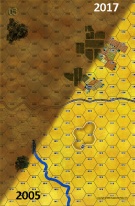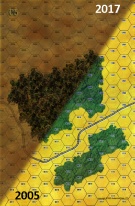Last Reserve
Lithuania's Iron Wolves #12
|
|
(Attacker)
Lithuania
|
vs |
Poland
(Defender)
|
|
|
|
Total |
| Side 1 |
1 |
| Draw |
0 |
| Side 2 |
0 |
|
Total |
| Side 1 |
1 |
| Draw |
0 |
| Side 2 |
0 |
|
Total |
| Side 1 |
0 |
| Draw |
0 |
| Side 2 |
0 |
|
| Overall Rating, 1 vote |
|---|
|
|
|
Scenario Rank:
--- of 957 |
| Parent Game |
Lithuania's Iron Wolves |
| Historicity |
Alt-History |
| Date |
1939-09-01 |
| Start Time |
06:00 |
| Turn Count |
22 |
| Visibility |
Day |
| Counters |
81 |
| Net Morale |
1 |
| Net Initiative |
1 |
| Maps |
2: 5, 6 |
| Layout Dimensions |
56 x 43 cm
22 x 17 in |
| Play Bounty |
173 |
| AAR Bounty |
222 |
| Total Plays |
1 |
| Total AARs |
0 |
| Duplicates |
IrWo005 |
|
Introduction
|
|
The tough Polish 1st Infantry Division moved away from Vilnius by rail soon after the start of the German invasion, leaving defense of the area to the hastily-mobilized 35th Reserve Division. Made up mostly of KOP border guards, the 35th was not nearly as formidable an opponent as the Pilsudski Legion. But with thousands of hastily-enrolled militia fighting alongside them, the Polish defenders of Vilnius (Wilno in their language) prepared to defend the ancient city.
|
|
Conclusion
|
|
The Poles fought hard against the invaders, but it was a doomed resistance and the Lithuanians steadily drove the Poles out of their positions and back into the suburbs of Vilnius. Knowing that the Lithuanians would not bombard their ancient capital – they had even begged the Germans not to bomb the city – the Polish defenders prepared to contest it house by house. But the Smigly-Rydz government ordered them to surrender the city rather than incur massive civilian casualties. Two weeks after crossing the border, the Lithuanians staged a triumphal entry into Vilnius.
|
Display Relevant AFV Rules
| AFV Rules Pertaining to this Scenario's Order of Battle |
- Vulnerable to results on the Assault Combat Chart (7.25, 7.63, ACC), and may be attacked by Anti-Tank fire (11.2, DFT). Anti-Tank fire only affects the individual unit fired upon (7.62, 11.0).
- AFV's are activated by tank leaders (3.2, 3.3, 5.42, 6.8).
They may also be activated as part of an initial activating stack, but if activated in this way would need a tank
leader in order to carry out combat movement.
- AFV's do not block Direct Fire (10.1).
- Full-strength AFV's with "armor efficiency" may make two anti-tank (AT) fire attacks per turn
(either in their action segment or during opportunity fire) if they have AT fire values of 0 or more
(11.2).
- Each unit with an AT fire value of 2 or more may fire at targets at a distance of between 100% and 150% of its
printed AT range. It does so at half its AT fire value. (11.3)
- Efficient and non-efficient AFV's may conduct two opportunity fires per turn if using direct fire
(7.44, 7.64).
Units with both Direct and AT Fire values may use either type of fire in the same turn as their opportunity fire,
but not both (7.22, 13.0).
Units which can take opportunity fire twice per turn do not have to target the same unit both times (13.0).
- Demoralized AFV's are not required to flee from units that do not have AT fire values (14.3).
- Place a Wreck marker when an AFV is eliminated in a bridge or town hex (16.3).
- AFV's do not benefit from Entrenchments (16.42).
- AFV's may Dig In (16.2).
- Closed-top AFV's: Immune to M, M1 and M2 results on Direct and Bombardment Fire Tables. Do not take step losses from Direct or Bombardment Fire. If X or #X result on Fire Table, make M morale check instead (7.25, 7.41, 7.61, BT, DFT).
- Closed-top AFV's: Provide the +1 modifier on the Assault Table when combined with infantry. (Modifier only applies to Germans in all scenarios; Soviet Guards in scenarios taking place after 1942; Polish, US and Commonwealth in scenarios taking place after 1943.) (ACC)
- Tank: all are closed-top and provide the +1 Assault bonus, when applicable
|
Lithuania Order of Battle


 LIWo011
LIWo011 



























